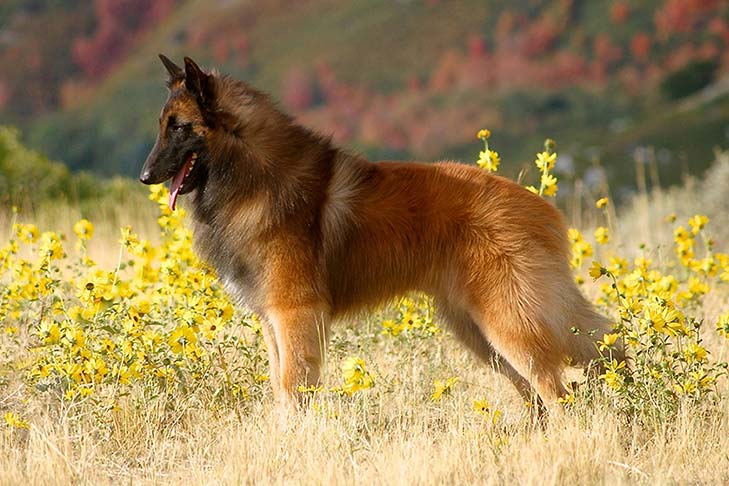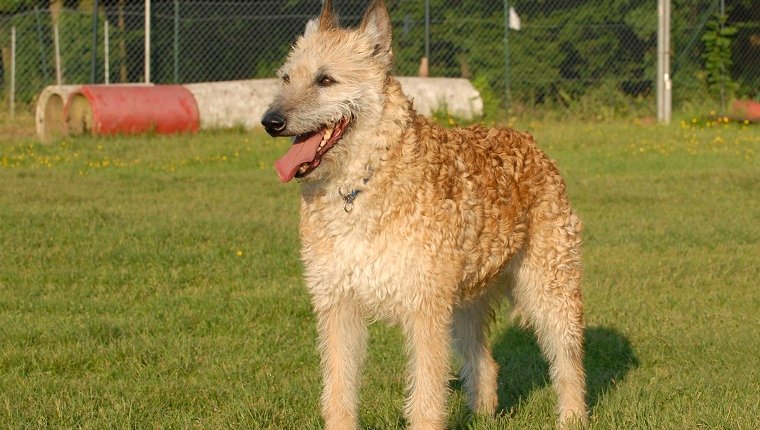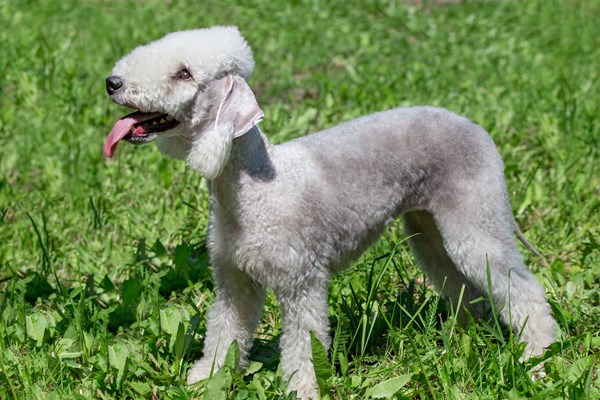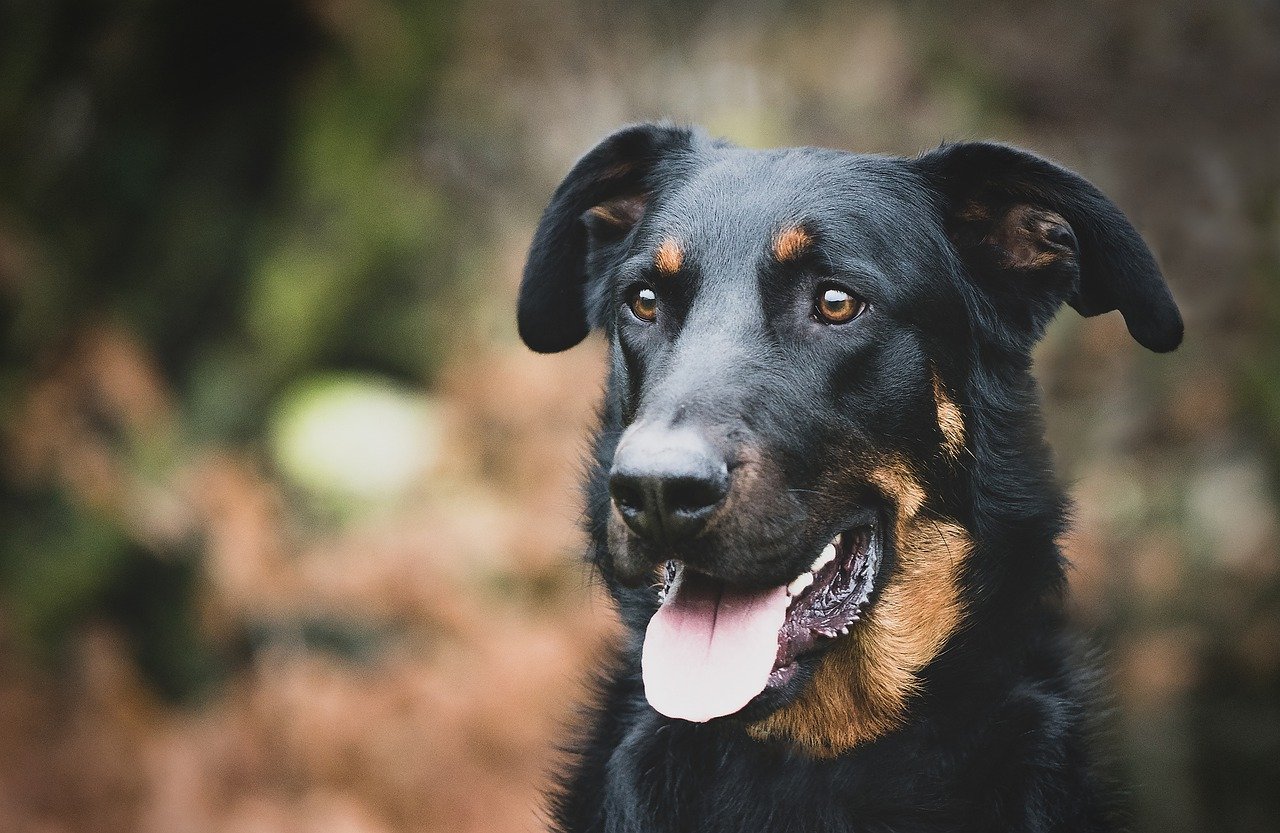Belgian Tervuren Dog Overview
This breed is a beautiful combination of elegance and strength.
Belgian Tervurens have a square build and medium bone. They are notable for their extremely haughty carriage.
Their walk is fluid and effortless rather than a hard-driving action, and their movement is bright, beautiful, and seemingly endless. These canines have a natural proclivity towards moving in circles rather than straight lines.
They have a dense undercoat and an exterior coat that is packed with guard hairs that are long, well-fitting, straight, and of mild roughness. Their expression is perplexed and inquisitive.
Belgian Tervuren Highlights
- In this breed, shyness might be an issue. Choose the puppy in the midst of the pack, not the one who is tearing up his littermates or hiding in the corner.
- Belgian Tervuren requires at least an hour of daily activity. If you don’t provide them exercise and cerebral stimulation in the form of training or play, they’ll find their own fun, which will almost certainly be costly to repair.
- Belgian Tervuren sheds all year and requires 15 to 20 minutes of brushing once a week.
- Tervs get along well with other dogs and cats if they are raised with them, but they have a strong pursuit instinct and will pursue animals who run away from them.
- Because Belgian Tervuren will chase joggers, bicycles, and motorists, they require a properly enclosed yard.
- Tervuren are extremely intelligent and vigilant. They have strong herding and defense instincts as well. Early and continuous training is essential!
- Despite their size, they are highly people-oriented and want to be part of family activities.
- Belgian Tervuren is a playful and sensitive dog. Maintain training sessions that are enjoyable, regular, and upbeat.
- Tervuren is not advised for inexperienced dog owners because of their intellect, intense energy, and other qualities.
- Do not attempt to buy a puppy from an unethical breeder, puppy mill, or pet store if you want a healthy dog. Look for a reliable breeder that checks her breeding dogs to ensure that they are free of hereditary illnesses that could be passed on to the puppies and that they have good temperaments.
Belgian Tervuren Breed Features & Ratings:
Rated base on a 5 Star Scale
ENERGY LEVEL: 4 Star
EXERCISE REQUIREMENTS: 5 Star
PLAYFULNESS: 5 Star
AFFECTION LEVEL: 4 Star
FRIENDLINESS TO DOGS: 3 Star
FRIENDLINESS TO OTHER PETS: 3 Star
FRIENDLINESS TO STRANGERS: 1 Star
WATCHFULNESS: 5 Star
EASE OF TRAINING: 5 Star
GROOMING REQUIREMENTS: 3 Star
HEAT SENSITIVITY: 3 Star
VOCALITY 5 Star
Belgian Tervuren Characteristics:
- Dog Breed Group: Herding Dogs
- Height: At the shoulder, it should be 21 to 26 inches tall
- Weight: 40 to 70 pounds
- Life Span: 10 to 12 years
- Type: Purebred
- AREA OF ORIGIN:
- DATE OF ORIGIN:
- OTHER NAMES:
- Temperament: Alert, Attentive, Energetic, Intelligent, Loyal, Protective
- Activities: Therapy, Agility, Conformation, Herding, Obedience, Rally, Search and Rescue, Tracking
- Color: Fawn to russet mahogany with black overlay
- Litter Size: 6 to 10 puppies
- Puppy Prices: $1500 – $2000 USD on average
Belgian Tervuren Health:
A reputable breeder will check breeding stock for health issues such as hip dysplasia, a deformity of the hip joint; elbow dysplasia; progressive retinal atrophy, which causes vision loss and blindness; and epileps.
As with all breeds, a Terv’s ears should be checked for symptoms of illness on a regular basis, and his teeth should be washed on a regular basis.
The National Breed Club recommends the following health tests:
- Hip Evaluation
- Elbow Evaluation
- Ophthalmologist Evaluation
- Thyroid Evaluation
Belgian Tervuren Grooming:
The Belgian Tervuren is a breed with two coats. The topcoat is densely packed with long, straight hair that is slightly rough to the touch but never scratchy or smooth.
The soft, dense undercoat protects the Terv from the elements and varies in thickness depending on the temperature.
The hair on the head of the dog, outside the ears, and on the front of the legs is short. Hair tufts cover the aperture of the ear.
The hair on the parts of the body is long and includes a mini-mane around the neck (called a collarette in males) and a fringe of long hair down the back of the front legs, back of the thighs, and on the tail.
The male, as in most species, is more decorative than the female.
The Belgian Tervuren coat is a deep, rich color that runs from fawn to reddish mahogany with a black overlay. The lighter guard hairs have black tips.
The chest of the pet is black or black and gray, the face is black with a black mask, also the ears are black, and the tail has a dark or black tip.
It is natural for Belgian Tervuren, particularly males, to darken with age, most notably on the shoulders, back, and rib area.
A nice coat in either sex never looks washed out or mainly cream or gray in color, though cream, light beige, or gray can be found on the underside of the tail, body, and back of the thighs. The toes’ tips may be white.
Tervs, like most double-coated dogs, shed all year. Males typically shed once a year, whereas females shed between heat cycles.
Brush out the coat once a week for 15 to 20 minutes to eliminate dead hair and avoid mats or knots.
You shouldn’t even have a lot of excess hair flying over your house if you do this, especially if you supplement the weekly brushing with a brief daily brushing of a minute or two.
Dental hygiene and nail care are two more grooming requirements. Brush your Terv’s teeth at least twice a week to remove tartar and the bacteria that live inside it. Brushing twice a day is even preferable if you want to avoid gum disease and foul breath.
If your pet’s nails don’t wear down gradually, you should cut them on a constant schedule.
The nails are lengthy if you can hear it clicking on the floor. Short, well trimmed nails maintain the dog’s feet in good condition.
When your Terv is a puppy, start exposing him to being brushed and examined. Handle his paws frequently – dogs’ feet are sensitive — and inspect his lips and ears.
Make grooming a pleasurable process full of praise and prizes, and you’ll build the framework for smooth veterinarian tests and other handling when he’s an adult.
Examine for sores, rashes, or symptoms of infection such as redness, tenderness, or inflammation on the skin, ears, nose, mouth, and eyes, and feet while you groom.
Ears should smell pleasant and be free of wax or crud, and eyes should be clear with no redness or discharge. Your thorough weekly examination will assist you in detecting potential health issues early on.
Belgian Tervuren Exercise:
According to the AKC standard, the Belgian Tervuren is “constantly in action, seemingly never tiring.” So, yeah, this is a dog who needs a lot of activity on a daily basis.
A Terv’s idea of heaven is a lot of hard work and tough play, ideally with his master rather than by himself.
This breed is not for every individual, and a Terv owner should anticipate spending a significant amount of active quality time with his canine companion.
Because of its strong herding instinct and rapid intelligence, the breed is suitable for a variety of sports including herding, agility, and obedience competitions, mushing, and Schutzhund (protection) exercises.
Belgian Tervuren Training:
The Belgian Tervuren requires socialization and obedience training. Introducing the puppy to a wide range of people, places, and situations will aid in his development into a well-adjusted, well-mannered adult.
Tervs’ intelligence and independence might get them into trouble if they aren’t trained to focus their endless energy into appropriate tasks.
Tervs are naturally playful and surprisingly sensitive, which means that severe training methods rarely work, but turning the chore into a game always does. Tervs take true pride in their ability to learn a new skill.
Belgian Tervuren Food and Nutrition:
Belgian Tervurens, like other dogs, thrive on a high-quality, protein-rich diet.
Make sure your dog’s food is tailored to their unique needs, such as age, activity level, and any pertinent health factors.
Tervs should be getting enough exercise to counteract weight gain, but if you observe your Tervuren gaining weight, you should either reduce their daily calorie intake or consult with your veterinarian—a healthy weight is essential for a long and healthy life.
Belgian Tervuren Temperament and Personality:
A good Belgian Tervuren is watchful and vigilant, which makes him an ideal watchdog.
A Terv is a self-assured guardian of his people and property, and he never attacks without reason. With people he knows, especially family members, he is loving and kind.
He also expects a lot of their time and attention. This breed dislikes being left alone; he prefers to be involved in family activities.
He demands a lot of mental stimulation in the form of training and play, especially with puzzle toys like Buster Cubes and interactive activities like fetch.
That traditional Tervuren attitude, however, does not just happen. A variety of things influence it, including genes, training, and socialization.
Puppies with good temperaments are interested and playful, eager to approach and be held by people.
Choose the puppy in the midst of the pack, not the one who is tearing up his littermates or hiding in the corner.
Excessive shyness can be an issue in this breed, so never adopt a fearful puppy, even if he makes you feel protective.
Make sure to meet at least one of the parents — generally the mother is present — to confirm that they have pleasant personalities with whom you are comfortable.
Meeting the parents’ siblings or other relatives is also beneficial in determining what a puppy will be like when he grows up.
Tervuren, like all dogs, requires early socialization — being exposed to a variety of people, sights, noises, and experiences — when they are young. Socialization aids in the development of your Tervuren puppy into a well-rounded dog.
Enrolling him in puppy kindergarten is a terrific place to start. Inviting guests over on a regular basis, as well as taking him to busy parks, stores that accept dogs, and on leisurely strolls to meet neighbors, will help him improve his social abilities.
Belgian Tervuren Care/Upkeep:
Belgian Tervurens have a lot of energy (the AKC describes them as “always moving”), so while they can make great family dogs, it’s crucial that they get enough physical and mental stimulation.
Even the most spoiled family Tervs enjoy hard work, such tough hobbies like agility and nose work are popular.
Because Belgian Tervurens like spending time with their humans, getting them involved in sports is a great way to meet their fitness needs while also strengthening their bond with their carers, this isn’t to suggest that a Terv won’t gladly unwind on the couch at the end of the day, but they do require caregivers who value exercise and will ensure they get enough of it.
Training a Tervuren isn’t simply simple; it’s also a must for a happy dog. Tervs excel at obedience training but require early socialization to guarantee they can behave with other dogs (their staunch characteristics don’t necessarily transition well to dog friendships without sufficient socialization).
For the best outcomes, use training to provide Belgian Tervurens with an alternative activity outlet and use positive reinforcement methods.
When it comes to grooming, all that fur in a Terv’s double layer coat has to go someplace, which means numerous brushings may be necessary, especially during their once-or-more-a-year shedding seasons.
Brushings can be reduced to once a week or so the rest of the year, but it is still suggested that they be done on a regular basis.
Tervs require the same grooming activities as other dogs, such as nail trimming, ear cleaning, and regular dental care, in addition to brushing.
Belgian Tervuren Relationship with Children and Other Pets
Tervs that have been well-socialized are good with children, especially if they have been raised with them, although because of their herding history, they may nip at their heels and try to herd them when playing.
You must teach Terv that such behavior is not acceptable. An adult Tervuren who is not used to being around children may do best in a family with old enough children to interact with him properly.
Constantly teach youngsters how to greet and handle dogs, and always monitor any encounter between pets and kids to avoid biting or ear or tail pulling on either party’s side.
Educate your children never to approach a sleeping or eating dog or to try to grab the dog’s food.
No canine should ever be left alone with a youngster. Tervs bond best with other dogs and cats if they are raised with them from puppyhood.
Sometimes they become closest friends with cats and other animals and defend them as if they were part of their flock, and other times they all agree to mutual indifference.
Tervs, on the other hand, have a chase impulse, and even if they don’t chase “their” cats, they may be unable to avoid chasing cats or other animals that invade their yards.
You must start early and praise acceptable behavior if you want your Terv to get along with other animals.
It is your obligation to keep your Terv under control in the presence of other animals if he has not been socialized with them.
Belgian Tervuren Names
| Rank | Boy Names | Girl Names |
| 01 | Max | Bella |
| 02 | Charlie | Lucy |
| 03 | Buddy | Daisy |
| 04 | Cooper | Molly |
| 05 | Jack | Lola |
| 06 | Rocco | Ella |
| 07 | Toby | Emma |
| 08 | Sam | Maggie |
| 09 | Buster | Coco |
| 10 | Teddy | Millie |
All About Belgian Tervuren
The Belgian Tervuren is one of the stunning medium-sized dog breeds encompassing a long, rich fawn to russet mahogany coat overlaid with a black blanket.
He has the same athletic build and an apparently unlimited supply of energy as all Belgian shepherd breeds.
Terv is a charming character known for his brilliance, elegance, alertness, and sense of humor. In the face of outsiders, he stands firm, confident in his capacity to safeguard his people and possessions.
He is affectionate and demanding of his family’s time and attention. This is a dog who enjoys participating in activities with you. And he has a wide range of abilities.
The Terv is no longer merely a herding dog. He works as a police dog, an assistance dog, and a therapy dog.
He competes in various dog sports, including herding (of course! ), agility, obedience, sledding (yes, sledding), and tracking.
The Belgian Tervuren is not often advised for persons who are new to dog ownership. His demeanor and level of activity can be daunting for folks who have never owned a working dog before.
Herding dogs, such as the Tervuren, are hardwired to follow a flock of sheep all day. That impulse does not go away simply because they are now living in a family household.
The Terv requires at least an hour of exercise per day and enough mental stimulation to keep him from becoming bored.
Suppose the dog is left to its own devices all day. In that case, he’ll either invent his own amusement — usually something you won’t like and will be expensive to repair — or develop separation anxiety.
While Terv is intelligent and easily trained, he is an independent thinker. To train him successfully, you must earn his trust and respect without resorting to rage, intimidation, or physical force.
Despite his confidence and strength, the Tervuren is sensitive, and severe corrections can harm his temperament, sometimes irrevocably.
He performs best when he is given firm, fair, and consistent regulations and prizes for appropriate behavior.
Tervs are committed to their families, particularly children, although they prefer to hang out with grownups.
They get to spend time well with other dogs and cats if raised with them, but they may have problems with unfamiliar animals who come onto their land.
They enjoy chasing — there’s that herding drive again! — so cats who stand their ground are likely to do better than those who flee.
That impulse to chase also endangers passing joggers and motorists; thus, a gated yard is required not just for the purpose of the safety of others but also for the Terv’s well-being.
The Belgian Tervuren combines the elegance and grace of a show dog with the love, devotion, and temperament of a companion dog, as well as the energy, athleticism, and intellect of a herding dog to create a breed that truly does it all.
If you are a very active and experienced dog owner looking for a canine companion for running, hiking, dog sports, or other activities, the Terv is a good choice.
Belgian Tervuren History:
The Belgian Tervuren is one of four shepherd dog breeds that originated in Belgium in the late 1800s.
The Malinois known for its fawn-mahogany, short coat with black mask, Tervuren (fawn-mahogany, long coat with black mask), Laekenois (fawn, rough coat), and Groenendael are the four variations (black, long coat).
In the U.S, AKC recognizes all four varieties as separate breeds, with the exception of the Laekenois, although the United Kennel Club recognizes all four types as one.
In September 1891, the Club du Chien de Berger Belge (Belgian Shepherd Dog Club) was created to decide which of the numerous diverse types of canines was the only representative of the shepherd dogs developed in Belgium.
Breeders and fanciers gathered on the outskirts of Brussels in November of that year to assess shepherd dogs from that region.
After a lengthy debate, veterinary professor Adolphe Reul and a panel of judges determined that the native shepherd dogs of that province were square, medium-sized dogs with well-set triangular ears and very dark brown eyes, with only texture and color and length of hair differing.
Subsequent dog exams in other Belgian provinces yielded similar results. Professor Reul created the first Belgian Shepherd Dog standard in 1892, distinguishing three types: dogs with long coats, short coats, and dogs with rough coats.
The first Belgian Shepherd dog show was held in Cureghem, Belgium, the same year, and the winner was a Tervuren named Duc II.
The Club du Chien de Berger Belge requested breed status from the Societe Royale Saint-Hubert (Belgium’s equivalent of the American Kennel Club) but was denied.
However, the Belgian Shepherd Dog, which included all four kinds, was officially recognized as a breed in 1901. Breeders decided to give each kind of Belgian Shepherd Dog its unique name.
Tervuren gets their name from a Belgian town where M. F. Corbeel produced Tom and Poes, two fawn-colored dogs who are regarded as the Tervuren breed’s foundation.
Belgian Shepherds were often utilized as draught dogs and guard dogs. They were the first dogs utilized by Belgian law enforcement.
Prior to World War II, international police dog trials were quite popular in Europe, and Belgian dogs won a number of awards.
When World War I happened, the military used several Belgian Shepherd Dogs for a variety of roles, including messenger dogs, Red Cross dogs, ambulance cart dogs, and, according to some, light machine-gun cart dogs.
Several Tervuren made it to the United States, but some failed to catch on and was extinct by the 1930s. More Tervuren was not imported for American breeding projects until 1953.
The AKC recognized the dogs as a distinct breed from the other Belgian Sheepdogs in 1959, and the American Belgian Tervuren Club was founded in 1960.
Terv’s elegance has made him a prominent show dog, and his working abilities have made him a superb herding dog since then.
Among the 155 breeds and types approved by the American Kennel Club, he is ranked 107th.
Where to Adopt Belgian Tervuren:
We always recommend starting with rescue. Belgian Tervuren Rescue Inc. will help you find a Tervuren for adoption, and you can also look via adoption websites like Petfinder and Adopt-a-Pet to see if you can find your perfect match.
If you’re wanting to acquire a Belgian Tervuren, the American Belgian Tervuren Club will help you find a reliable breeder.
More Dog Breeds and Further Research:
There are numerous good dogs out there! And if you adore the Belgian Tervuren, you might be interested in the following breeds:
Belgian Tervuren Fun Facts:
- They Were Bred To Be Herding and Guard Dogs.
- In Some Countries, the Tervuren Is Not a Separate Breed.
- They Were Named After a Belgian Village.
- The Foundation Couple Worked at a Brewery.
- The First Ever AKC Herding Champion Was a Tervuren.
Frequently Asked Questions (FAQs):
Belgian Tervurens are intelligent and sensitive dogs. They perform best when they are exposed to a variety of mental and physical stimuli; otherwise, they may devise their own, sometimes harmful, methods of escaping boredom.
In the past, Belgian Tervuren, or Terv for short, were utilized as police and military dogs, as well as messenger animals and Red Cross canines. Today, they continue to amaze people by working as police dogs, assistance dogs, show dogs, and herders (no surprise there).
Is it normal for Belgian Tervuren dogs to bark a lot? When compared to other dog breeds, the Belgian Tervuren barks a lot.




